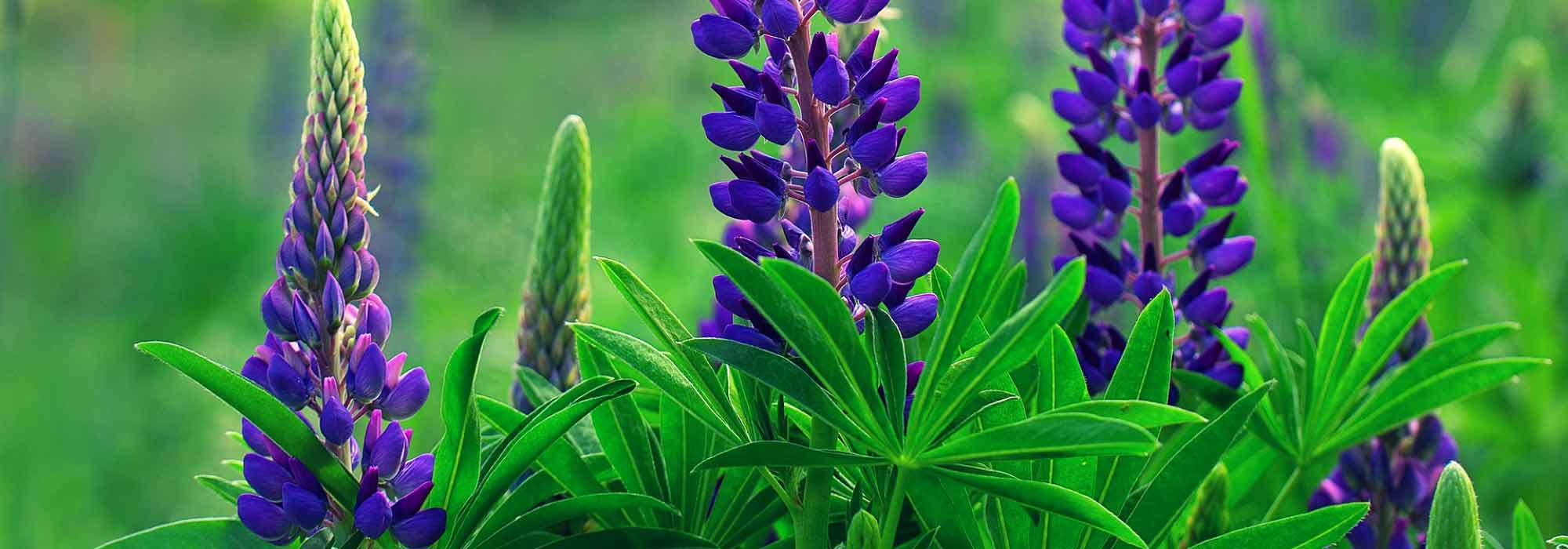
Lupin: sowing, planting and care
Contents
Lupin in a nutshell
- Lupin is a garden classic, emblem of English gardens
- It is spectacular with tall upright spikes covered in colourful flowers
- From May to August, its majestic flowering in pink, white, red, blue, purple or yellow never fails to impress!
- Annual or perennial, easy to grow in fresh, non-calcareous soil in sun or partial shade and requires no maintenance
- It provides structure and vertical interest to beds, borders, rockeries, containers and bouquets
A word from our expert
Well known in gardens, the Lupin or lupinus is an annual or perennial plant, remarkable for its impressive flowering from late spring to mid-summer.
Lupin is a legume both edible and ornamental, equally for eating and for admiring in gardens!
With its opulent, upright spikes of very colourful flowers, Lupin is emblematic of English gardens, romantic gardens and natural ones, where it introduces vertical accents and focal points at the back of beds, in borders or in pots or planters near the house.
C’est un grand classique, une valeur sûre des massifs sans entretien.
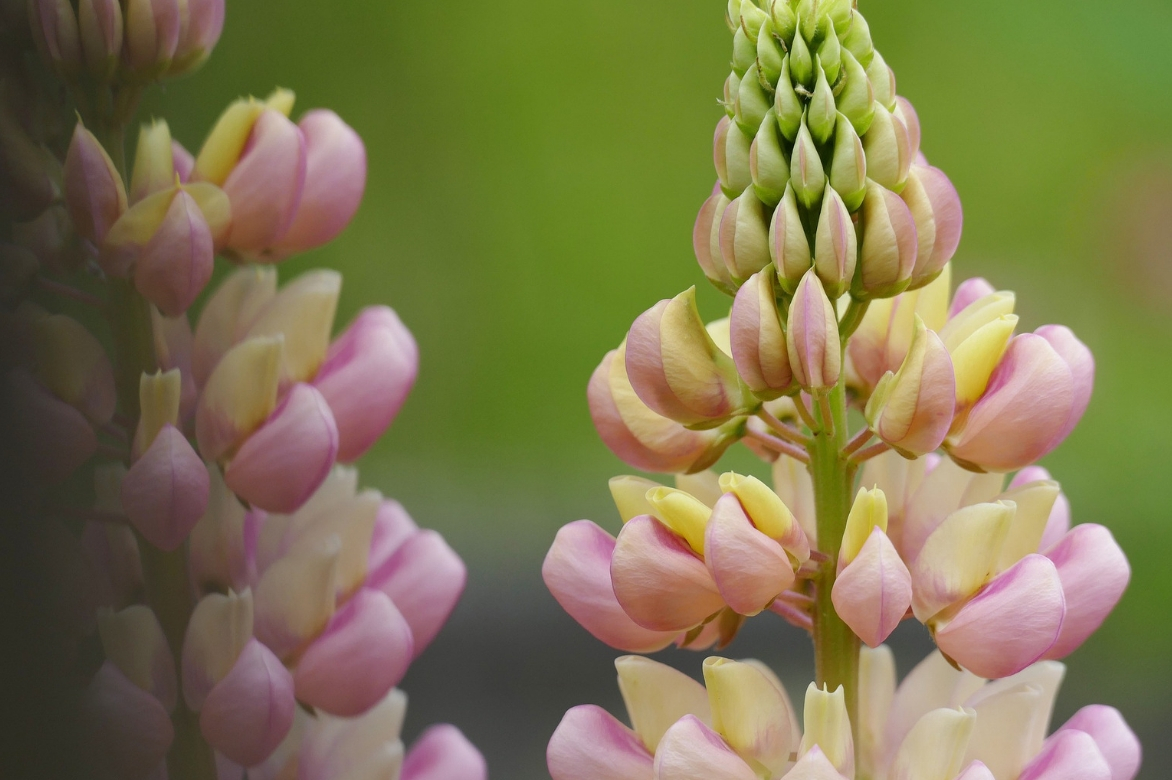
It also makes an excellent green manure!
There are hardy perennial lupins across all regions and single annual lupins, such as white lupin (grown mainly for food), whose sowing is very easy.
They are very easy to grow in ordinary, even clay, soil and quickly form floriferous clumps in sun or semi-shade.
Discover our lupin collections, luxuriant, carefree plants, easy to plant, to sow and to care for, accessible to all gardeners!
Description and botany
Botanical data
- Latin name Lupinus
- Family Fabaceae, Legumes
- Common name Garden lupin, Tree lupin
- Flowering June to August
- Height 0.45 to 1.20 m
- Exposure Sun, partial shade
- Soil type Any, well-drained
- Hardiness -15°C to -20°C depending on varieties
The Lupin or Lupinus is a perennial, bushy or annual plant depending on species, belonging to large family Fabaceae, formerly known as Papilionaceous or Legumes, like wisteria, broom or sweet pea. The genus Lupinus comprises nearly 200 species native to dry meadows, hills, open woods, coastal strips, cliffs or riverbanks around Mediterranean basin, North Africa and across the Americas.
While Lupinus polyphyllus, the garden perennial lupin, is the most common species, there are many perennial hybrids, notably the lupinus x russellii or Russell hybrids obtained by cross-breeding Lupinus polyphyllus with Lupinus hartwegii (hairy lupin), an annual species.
Varieties belonging to the group of Russell hybrids are widespread in gardens, such as ‘Le Chandelier’, ‘La Châtelaine‘ or ‘La Demoiselle’, which are among best-known cultivars. Occasionally encountered is Lupinus arboreus, the arborescent lupin, a bush that can reach 2 m in height, and Lupinus nanus ‘Pixie Delight’, a dwarf lupin only 50 cm tall.
Some annual species such as Lupinus alba, white lupin, Lupinus luteus, yellow lupin, and Lupinus cruckshanksii (or mutabilis) with changing colours, grouped under name of ‘sweet lupins’, are grown for food or forage because of their seeds very rich in protein. They can also be cultivated as ornamentals.
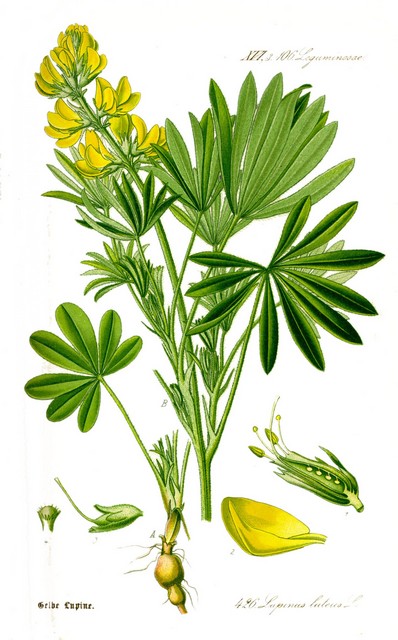
Lupinus luteus – botanical illustration
From a strong taproot that anchors deep in soil, lupin forms an erect, bushy and vigorous clump with a more or less compact habit and height ranging from 45 cm in flower, with similar spread, up to around 1.50 m. Size varies with variety but most lupins remain medium-sized and rarely exceed 90 cm in height.
Although growth is rapid, perennial species are short-lived, living about 3 to 5 years, but they self-seed easily.
Lupin quickly forms a dense shrub with strikingly architectural foliage. Deciduous leaves, mainly basal, are palmate, divided into rosettes of five to 12 lanceolate to spatulate leaflets radiating from a single petiole. Measuring 1 to 6 cm long, leaves are bright green to silvery green and often covered with silky hairs beneath.
Lupins’ showy flowering never goes unnoticed.
From this clump of deeply divided leaves emerge, from late spring to mid-summer, sometimes with a repeat in September, the long, upright spikes so characteristic, borne on a thick flowering stem.
Small flowers 1 to 2 cm long are grouped along this spike in compact clusters sometimes reaching up to 60 cm in length. With fused petals and an asymmetrical shape, lupin flowers resemble those of peas.
Flower buds open successively from base to tip of spike, extending display of these impressive but, like delphiniums, unfortunately rather short-lived blooms.
In first year of flowering, plant tends to produce spikes of disciplined regularity, while in following years it will display many leading shoots of varying sizes.
These plump cones densely covered with pea flowers bear bright and varied colours of carmine pink, red, lilac, blue, orange, purple or white. Some flowers are bicoloured, notably in variable lupins, combining white with another colour.
These tall, vividly coloured inflorescences, sometimes very fragrant, emit a delicate peppery scent similar to that of wisteria and sweet pea.

Palmate foliage, highly decorative / flowers, always spectacular / pods containing developing seeds
Highly melliferous, they attract many pollinating insects throughout season.
Lupin flowers are lovely in fresh country-style bouquets with romantic feel.
Once faded, lupin flowers turn into pods containing seeds that can reach up to 14 cm in diameter and which readily self-sow. Garden lupin seeds contain bitter toxic alkaloids while seeds of so-called annual “sweet” lupins are grown for their very low alkaloid content. Since antiquity, large yellow lupin seeds have been eaten as a snack, pickled like olives.
Easy to grow, hardy down to about -15°C for perennial species, lupin prefers a sunny or partially shaded site with soil rich in humus, deep, staying cool during growing season and above all non-calcareous, as it dislikes lime as well as excess winter wet.
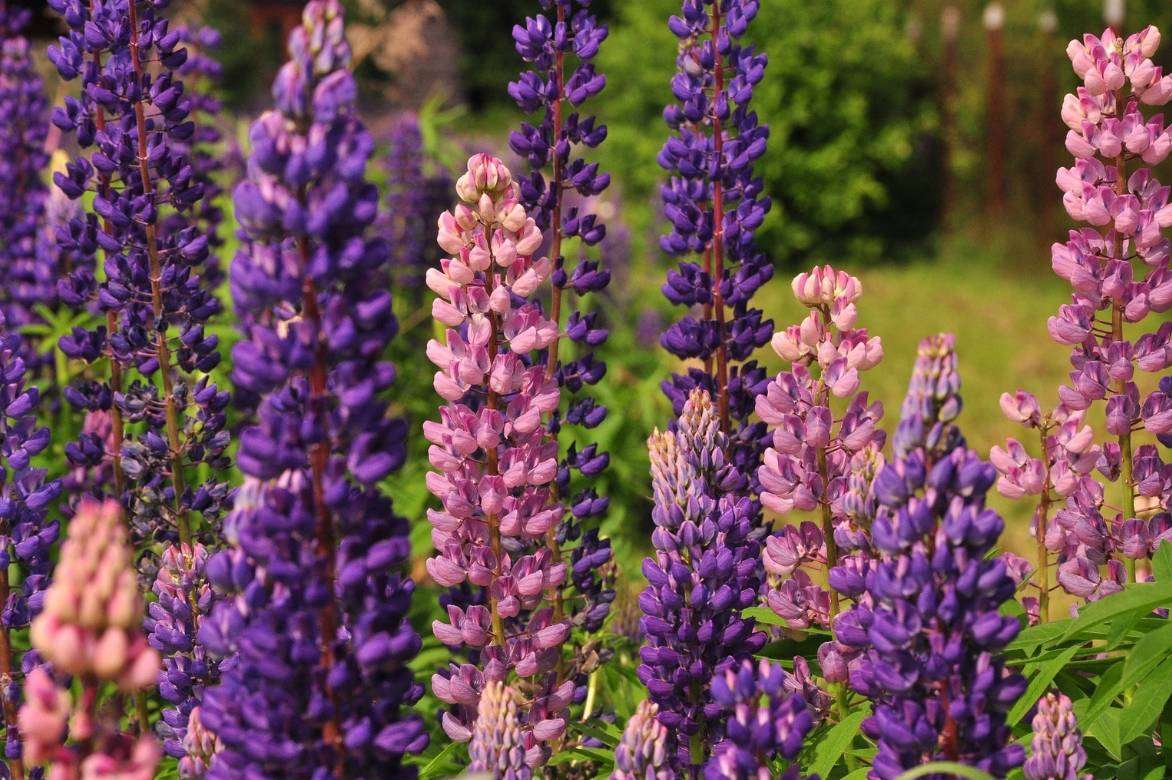
Whether perennial or annual, lupin is a reliable choice for perennial borders, a showpiece in English gardens. It fits perfectly into naturalistic borders to compose displays that are exuberant yet ephemeral.
With its columnar habit, it is valuable for adding verticality at back of border, in flowerbeds or even in a pot near house.
Lupin is also grown as green manure because its roots release nitrogen, improving poor soils over years. Today, seeds of food lupins, rich in protein, are processed into flour — a reminder that lupin is a legume!
Main species and varieties
The most widespread lupin varieties are Russell perennial hybrids, available in almost every colour, such as ‘Le Chandelier’, ‘La Châtelaine’ or ‘La Demoiselle’. Also found are lupins from the “Gallery” series which groups very squat, vigorous and remarkably floriferous hybrids, easy to integrate into beds and pots.
Apart from these hardy lupins, many other species are found, notably annual lupins such as Lupinus cruckshanksii and the villous lupin (Lupinus Hartwegii).
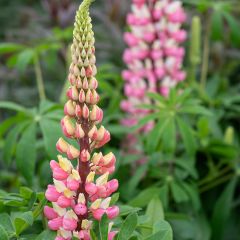
Lupinus polyphyllus The Chatelaine
- Flowering time July, August
- Height at maturity 90 cm
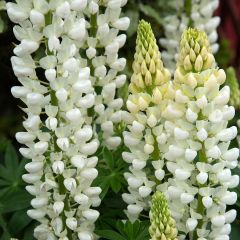
Lupinus polyphyllus Noblemaiden
- Flowering time July to September
- Height at maturity 90 cm
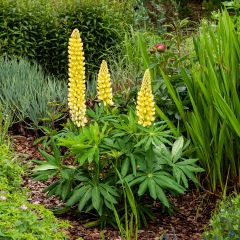
Lupinus polyphyllus Chandelier
- Flowering time July, August
- Height at maturity 90 cm

Lupinus The Governor
- Flowering time July, August
- Height at maturity 90 cm

Lupinus West Country Manhattan Lights
- Flowering time July, August
- Height at maturity 80 cm

Lupinus polyphyllus My Castle
- Flowering time July, August
- Height at maturity 90 cm
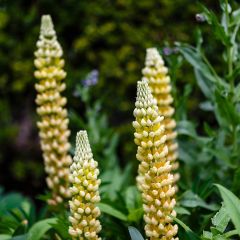
Lupinus Gallery Yellow
- Flowering time June to August
- Height at maturity 60 cm
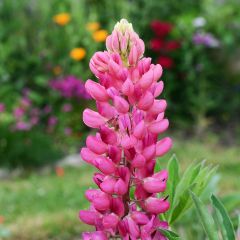
Lupinus Gallery Pink
- Flowering time July, August
- Height at maturity 60 cm

Lupinus arboreus
- Flowering time June, July
- Height at maturity 2 m

Lupinus Avalune Red-White - Annual Lupin Seeds
- Flowering time July, August
- Height at maturity 40 cm

Lupinus Avalune Lilac - Annual Lupin Seeds
- Flowering time June to November
- Height at maturity 40 cm
Discover other Lupinus - Lupin
View all →Available in 2 sizes
Available in 2 sizes
Available in 1 sizes
Available in 3 sizes
Available in 1 sizes
Available in 3 sizes
Available in 1 sizes

Available in 2 sizes
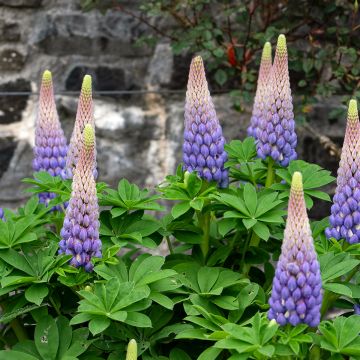
Available in 1 sizes
Available in 1 sizes
Planting
Where to plant Lupins?
Perfectly hardy down to -15 to -20°C, the Lupin perennial tolerates cold winters and thrives in many parts of France. Lupin is rather a plant of cool climate.
Annual or perennial, it is an easy-to-grow plant that prefers sunny positions essential for good flowering. It will tolerate light shade in southern regions.
Although lupins do well in any good, well-drained garden soil, even poor soil, they prefer rich soils, neutral to slightly acidic, that stay cool during the growing season and, above all, are free of lime. They will even tolerate clay soils if sufficiently fertile. They will adapt to poor soil but will be less luxuriant.
Cultural needs of some lupins differ. This is the case for Lupinus arboreus, which prefers a light, free-draining, even dry soil.
All lupins cannot tolerate wet, poorly drained soils in winter.
Lupin has a wide ground spread and its taproot does not like transplanting. Offer it a space suited to its ample development: growth is rapid and it will often reach up to 75 cm wide at ripeness. It must not be crowded; surround it with plants that have little ground spread.
The arborescent lupin forms a clump nearly 2 m across. A well-exposed site sheltered from strong winds, which could shorten the flowering, will encourage the plant to reach full height.
By nature somewhat free-seeding, lupin will self-seed when conditions suit it.
Lupins remain interesting focal points in a garden. Planted in groups, they structure space and bring verticality, texture and presence to natural gardens, to the middle or back of large perennial herbaceous beds, along a wall or on a raised bank.
They help give structure to rather flat beds and add relief to a mixed-border.
Low varieties fit more easily on the edge and in a pot on a sunny terrace.
When to plant perennial lupin?
Perennial lupin buckets are best planted in spring after last frosts, from March to May, or in autumn from September to November.
How to plant perennial lupin?
In open ground
Planting in groups is often preferred: allow 1 to 4 plants per m2 to create attractive coloured drifts. The lupin is also striking alone in the middle of the short grass meadow.
- Dig a hole 2 to 3 times the volume of the bucket
- Fork the soil deeply
- Add river sand, clay pebbles OR gravel to the bottom of the hole
- Backfill with 1/3 garden soil, 1/3 well-rotted compost and 1/3 potting compost
- Plant the collar at soil level. Firm and water well with rainwater
- Apply organic or mineral mulch
How to plant a lupin in a pot
The less vigorous Lupin varieties tolerate being grown in a pot provided they are repotted every two years into a pot one and a half times larger than the previous one, because Lupin roots tend to circle the pot (chignonnage).
Plant lupin in a mix that is both rich and very free-draining to prevent moisture from stagnating at the roots.
- In a pot of at least 50 cm diameter, lay a good draining layer of gravel or clay pebbles
- Plant in a slightly sandy potting mix
- Water regularly
- Mulch the base

Lupins in situation with evening primroses, roses and peonies (photo PAP)
When and how to sow annual lupin?
Sowing outdoors
Annual lupin seeds are among easiest to sow. Only start sowing once soil has warmed up, directly in ground in April–May. Flowering will then occur only the following year.
- Sow in a « poquet » of 3 lupin seeds per hole at 5–6 mm depth, spacing 20–30 cm apart
- Keep soil moist during germination
- Sowings emerge after 18–25 days
- Keep only strongest young plants
Under cover
It is also possible to sow your lupin seeds under cover in autumn.
- In buckets, sow in groups of 3 seeds
- Cover seeds with a few millimetres of potting compost
- Keep in light and warm conditions
- In spring, plant young plants into pots or in garden without crowding them too closely, as each young plant will quickly take up space.
Learn more in our step-by-step tutorial: How and when to sow lupins?
Pruning and care
Undemanding, Lupin requires little care. It is fairly greedy for water: during growing season, give regular waterings to encourage flowering; favour rainwater, lupin dislikes lime-rich water.
Once established, Lupin will tolerate occasional drought. Water only during heatwaves or prolonged drought.
Water potted lupins during summer at least once a week. Repot every two years into a larger pot.
Keep soil cool during growing season to encourage flowering: a mulch to maintain coolness is recommended.
Before winter, in cold regions, mulch the stump at the base.
In poor soil, add compost in March and in autumn to encourage profuse flowering.
Remove faded flowers to encourage reflowering in autumn.
Cut back flower spikes of perennial lupins as soon as they finish flowering; this will prevent self-seeding that can needlessly exhaust the plant and shorten its lifespan. Keep some seeds to maintain clumps, as lupins live only 4 or 5 years.
Lupin clumps lose vigour over the years and disappear quickly (in 4–5 years): every two or three years, divide stumps to rejuvenate them.
When and how to prune lupins
Pruning is limited to a simple spring tidy. In March, at the start of growth, cut back old foliage by half to encourage new shoots.

Raindrops on a lupin leaf
Diseases and potential pests
Robust, though short-lived, Lupin nevertheless has some well-known enemies.
In spring, protect young foliage from ravenous slugs. Plan a slug-control treatment from February and follow our tips to deter gastropods.
The lupin aphid can disfigure plants and cause leaf mottling: get rid of these pests by spraying soapy water.
In autumn, downy mildew and powdery mildew sometimes attack leaves of perennial lupins, dusting them with a white, felt-like coating. Spray Bordeaux mixture or nettle and horsetail manure preventively and burn affected parts. Discover our fact sheet on combating powdery mildew.
Not serious, rust-coloured, brown or black foliar spots can also damage foliage. As prevention, carry out regular sprays of horsetail decoction. If infection occurs, cut affected leaves and burn them.
In poorly drained soil, perennial lupin will suffer from winter damp, causing root rot.
Propagation
Once well established, Lupin will not like to be disturbed either, division is possible but rather delicate. You can carry out sowing to increase clumps, knowing that lupin generally self-seeds. Sowing takes a long time and flowering colour will be unpredictable!
Follow our advice above to sow lupin seeds.
Division
Division of lupins is a good way to renew your plants. Only divide clumps at least 3 years old.
- In March, use a fork-spade to dig up the clump without damaging fragile roots
- Separate the clump into several divisions, each with roots and shoots; if necessary, use a saw
- Replant each new division immediately.
→ Read also: How to propagate lupins to enhance your garden?
Companion planting with lupins
With its vibrant leading shoots of energy that bring grandeur, balance and colour to borders, the Lupin is easy to pair with a large number of annuals or summer-flowering perennials. It makes its mark in all natural gardens to create displays as exuberant as they are fleeting.
Highly structuring, its majestic clusters of flowers are centrepieces of English cottage gardens and herbaceous borders. It is useful to structure natural meadows, valuable for introducing vertical accents and focal points at the back of a border, in edges or large containers near the house.

An idea for a combination: Lupinus ‘West Country Masterpiece’, Cirsium rivulare ‘Atropurpureum’, Iris germanica ‘Blue Crusader’, Salvia nemorosa ‘Caradonna’, Verbascum ‘Southern Charm’, Camassia leichtlinii ‘Caerulea’, Geranium macrorrhizum ‘Bevan’s Variety’ and Aquilegia ‘Clementine Dark Purple’
Its presence also helps to balance volumes in lush borders. The upright habit and the pure or soft colours of lupin lend themselves to every whim.
It is also a staple of white gardens, pink, mauve or purple schemes or blue gardens.
Perennial or annual lupin is perfect for playing on contrasts or nuances in subtle monochrome schemes or in complementary harmonies such as pink/green, for example.
In a rich, romantic scene, against a backdrop of old roses, mix a few clumps of white or pastel lupins with Astrantias, foxgloves, gauras and lavenders.
In a generous scheme where pink prevails, dare the vibrant pairing of a pink lupin with corn poppies, peonies, Oriental poppies, perennial sweet peas.

A tone-on-tone example: Cornus controversa ‘Variegata’, Lupinus ‘La Demoiselle’, Miscanthus sinensis ‘Rigoletto’ (variety close to ‘Morning Bright’ or ‘Variegatus’) / Landscape designer Yvonne Innes – Photo credit Nicole and Patrick Mioulane /
The flattened or globular flowerheads of euphorbias, achilleas or ornamental alliums will lend themselves to striking shape contrasts alongside lupins’ slender spikes.
To crown a natural meadow, among clumps of lupins, plant, leaving enough room for them, hollyhocks, foxgloves, thistles, galegas, cornflowers, veronicas, daisies, cosmos.
Spectacular at the back of an opulent border alongside delphiniums, provide it in counterpoint with light grasses of soft or linear forms and offer it a smoke tree with purple foliage as backdrop.
To give breath and originality to summer containers, surround lupin with other perennials or annuals flowering in summer; dwarf campanulas, arums, verbenas, hardy geraniums, coreopsis, lobelias, petunias or salvias.
Useful resources
- Discover our unique collection of lupin seeds, easy to sow!
- Follow our tips to keep slugs away from your young lupin plants!
- Create a romantic border with your lupins!
- Lupins are must-haves for low-maintenance borders
- Lupins: 6 ideas for combining them
- Subscribe!
- Contents
. Happy gardening! Lupinus](https://en.promessedefleurs.eu/blogwp/wp-content/uploads/2018/12/lupin-tout-savoir.jpg)































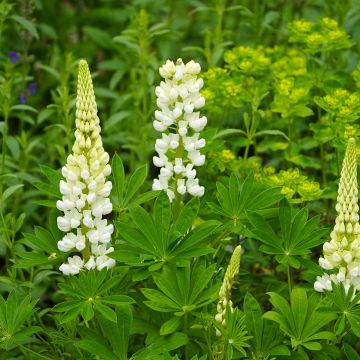

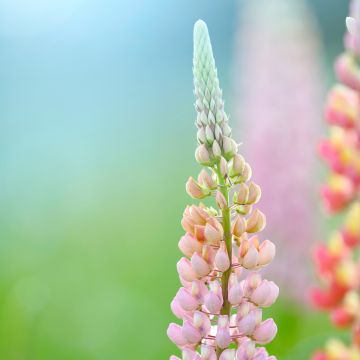

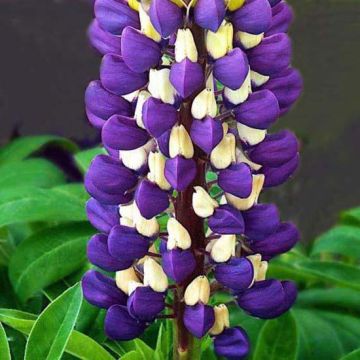

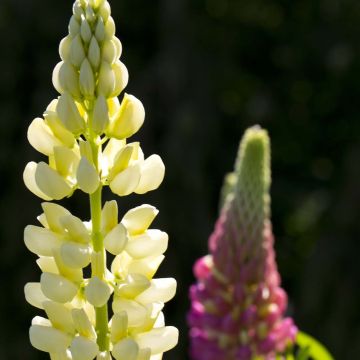

Comments